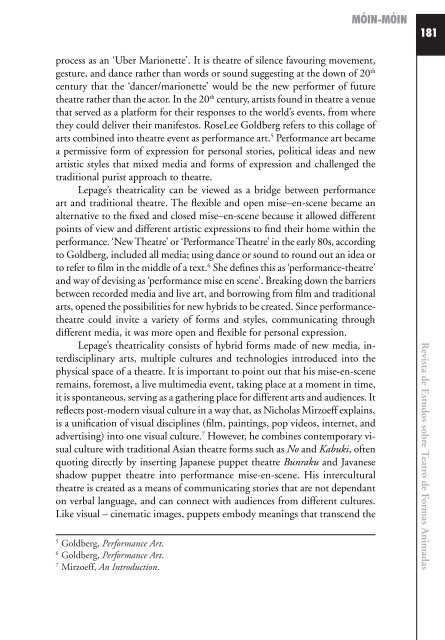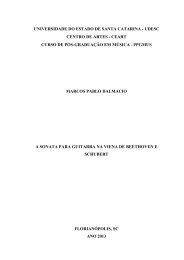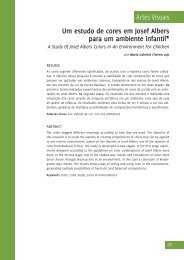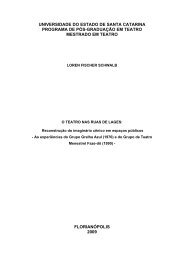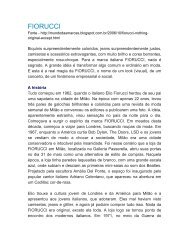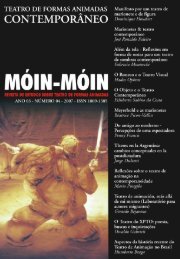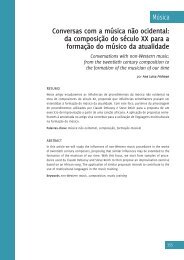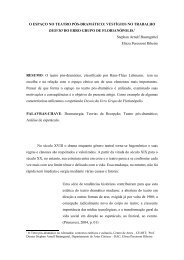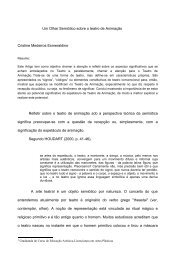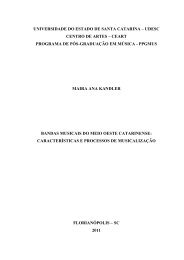Edição e distribuição www.designeditora.com.br Tipologia Adobe ...
Edição e distribuição www.designeditora.com.br Tipologia Adobe ...
Edição e distribuição www.designeditora.com.br Tipologia Adobe ...
You also want an ePaper? Increase the reach of your titles
YUMPU automatically turns print PDFs into web optimized ePapers that Google loves.
process as an ‘Uber Marionette’. It is theatre of silence favouring movement,<<strong>br</strong> />
gesture, and dance rather than words or sound suggesting at the down of 20 th<<strong>br</strong> />
century that the ‘dancer/marionette’ would be the new performer of future<<strong>br</strong> />
theatre rather than the actor. In the 20 th century, artists found in theatre a venue<<strong>br</strong> />
that served as a platform for their responses to the world’s events, from where<<strong>br</strong> />
they could deliver their manifestos. RoseLee Goldberg refers to this collage of<<strong>br</strong> />
arts <strong>com</strong>bined into theatre event as performance art. 5 Performance art became<<strong>br</strong> />
a permissive form of expression for personal stories, political ideas and new<<strong>br</strong> />
artistic styles that mixed media and forms of expression and challenged the<<strong>br</strong> />
traditional purist approach to theatre.<<strong>br</strong> />
Lepage’s theatricality can be viewed as a <strong>br</strong>idge between performance<<strong>br</strong> />
art and traditional theatre. The flexible and open mise–en-scene became an<<strong>br</strong> />
alternative to the fixed and closed mise–en-scene because it allowed different<<strong>br</strong> />
points of view and different artistic expressions to find their home within the<<strong>br</strong> />
performance. ‘New Theatre’ or ‘Performance Theatre’ in the early 80s, according<<strong>br</strong> />
to Goldberg, included all media; using dance or sound to round out an idea or<<strong>br</strong> />
to refer to film in the middle of a text. 6 She defines this as ‘performance-theatre’<<strong>br</strong> />
and way of devising as ‘performance mise en scene’. Breaking down the barriers<<strong>br</strong> />
between recorded media and live art, and borrowing from film and traditional<<strong>br</strong> />
arts, opened the possibilities for new hy<strong>br</strong>ids to be created. Since performancetheatre<<strong>br</strong> />
could invite a variety of forms and styles, <strong>com</strong>municating through<<strong>br</strong> />
different media, it was more open and flexible for personal expression.<<strong>br</strong> />
Lepage’s theatricality consists of hy<strong>br</strong>id forms made of new media, interdisciplinary<<strong>br</strong> />
arts, multiple cultures and technologies introduced into the<<strong>br</strong> />
physical space of a theatre. It is important to point out that his mise-en-scene<<strong>br</strong> />
remains, foremost, a live multimedia event, taking place at a moment in time,<<strong>br</strong> />
it is spontaneous, serving as a gathering place for different arts and audiences. It<<strong>br</strong> />
reflects post-modern visual culture in a way that, as Nicholas Mirzoeff explains,<<strong>br</strong> />
is a unification of visual disciplines (film, paintings, pop videos, internet, and<<strong>br</strong> />
advertising) into one visual culture. 7 However, he <strong>com</strong>bines contemporary visual<<strong>br</strong> />
culture with traditional Asian theatre forms such as No and Kabuki, often<<strong>br</strong> />
quoting directly by inserting Japanese puppet theatre Bunraku and Javanese<<strong>br</strong> />
shadow puppet theatre into performance mise-en-scene. His intercultural<<strong>br</strong> />
theatre is created as a means of <strong>com</strong>municating stories that are not dependant<<strong>br</strong> />
on verbal language, and can connect with audiences from different cultures.<<strong>br</strong> />
Like visual – cinematic images, puppets embody meanings that transcend the<<strong>br</strong> />
5 Goldberg, Performance Art.<<strong>br</strong> />
6 Goldberg, Performance Art.<<strong>br</strong> />
7 Mirzoeff, An Introduction.<<strong>br</strong> />
MÓIN-MÓIN<<strong>br</strong> />
181<<strong>br</strong> />
Revista de Estudos so<strong>br</strong>e Teatro de Formas Animadas


